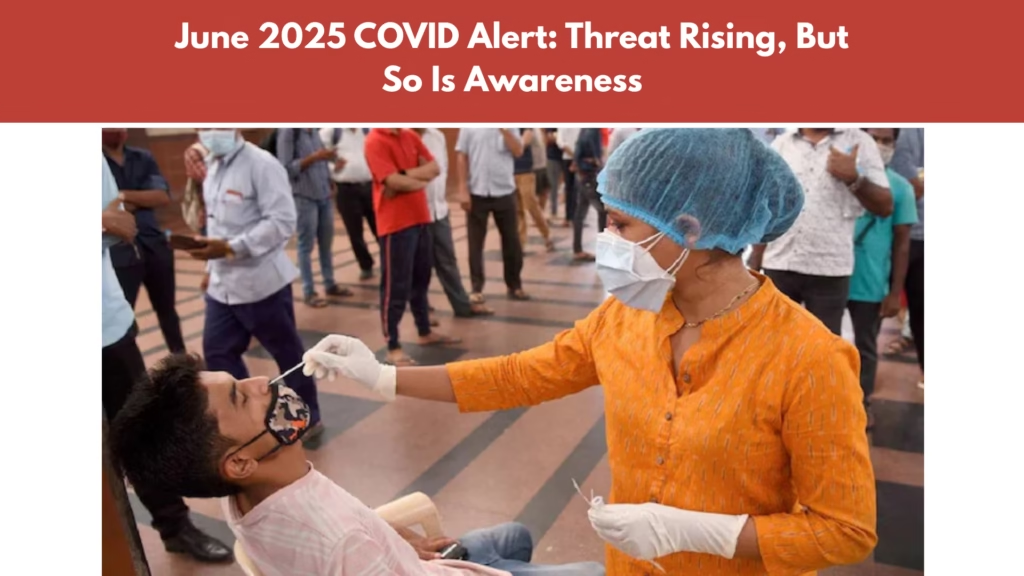COVID 19 Comes Back in 2025: Don’t Panic, Be Prepared

COVID 19
COVID 19 updates : As of June 2025, a new COVID 19 variant, NB.1.8.1, has emerged, leading to a noticeable increase in cases across several countries, including India. This variant, a descendant of the Omicron lineage, is under close observation by global health authorities due to its rapid spread and unique characteristics. In this article, we will explore the origins, symptoms, global impact, and preventive measures related to NB.1.8.1.
Origins and Classification
NB.1.8.1 is a subvariant of the Omicron lineage JN.1. First identified in January 2025, it has since been detected in multiple countries, including China, the United States, and India. The World Health Organization (WHO) has designated NB.1.8.1 as a Variant Under Monitoring (VUM), indicating that it possesses genetic changes that may affect virus characteristics, but the evidence is not yet sufficient to classify it as a Variant of Concern or Interest.

Symptoms Associated with NB.1.8.1
The symptoms of NB.1.8.1 are largely consistent with those of previous Omicron variants. Commonly reported symptoms include:
- Sore throat
- Fatigue
- Mild cough
- Fever
- Muscle aches
- Congestion
- Gastrointestinal issues
- Blurred vision
- Nausea or dizziness
- Difficulty concentrating
Notably, some patients have reported persistent low-grade fever and gastrointestinal symptoms, which are somewhat distinct from earlier strains.
Global Spread and Impact
NB.1.8.1 has been identified in over 22 countries, with significant case numbers reported in China, Hong Kong, and the United States. In China, the variant has led to a sharp increase in hospitalizations, particularly among older adults. In the U.S., cases have been detected in several states, including New York and California, primarily among international travelers.
In India, the variant has contributed to a resurgence of COVID 19 cases, with active infections rising significantly in states like Kerala, Maharashtra, and Delhi. As of early June 2025, India has reported over 3,700 active cases, marking a substantial increase from previous weeks.
Transmissibility and Severity
NB.1.8.1 carries several spike protein mutations, including T22N, F59S, G184S, A435S, V445H, and T478I. These mutations may enhance the variant’s ability to bind to human cells and potentially evade immune responses.
Despite these mutations, current evidence suggests that NB.1.8.1 does not cause more severe illness than previous variants. However, its increased transmissibility could lead to higher case numbers, which may strain healthcare systems, especially if vulnerable populations are affected.
Preventive Measures and Recommendations
To mitigate the spread of NB.1.8.1, health authorities recommend the following measures:
- Vaccination: Ensure you are up to date with COVID 19 vaccinations and booster shots.
- Mask-Wearing: Wear masks in crowded or enclosed spaces, especially where ventilation is poor.
- Hand Hygiene: Regularly wash hands with soap and water or use hand sanitizers.
- Testing and Isolation: If you experience symptoms, get tested promptly and isolate to prevent transmission.
- Stay Informed: Keep abreast of local health advisories and guidelines.
In regions like Karnataka, India, schools and colleges have been advised to exercise caution, with symptomatic students encouraged to stay home and institutions instructed to maintain strict sanitation protocols.
🧬 1. How NB.1.8.1 Differs Genetically
COVID 19 The NB.1.8.1 variant stands out due to specific spike protein mutations like T478I and V445H, which may improve its ability to bind to human cells. These genetic changes can help the virus evade immune responses, especially in individuals with waning vaccine protection or without prior Omicron infection. Scientists are actively studying how these mutations affect the variant’s behavior and what it could mean for vaccine effectiveness.
📉 2. Impact on Travel and Economy
As cases of NB.1.8.1 spread, several countries have begun reviewing their travel protocols. Although no global travel bans have been imposed as of June 2025, many airports are reintroducing random testing for international passengers. In sectors like hospitality and tourism, bookings have slowed due to rising public concern — especially in countries like China and India, which are reporting fresh surges.
🏫 3. COVID Protocols in Schools and Colleges
In India, especially in states like Karnataka, schools have been advised to follow enhanced COVID 19 protocols again. This includes daily temperature checks, frequent hand sanitization, and advising symptomatic children to stay home. Although offline classes continue, there is growing debate about a possible shift to hybrid learning if the infection rate climbs further.
💉 4. Booster Vaccine Developments
Pharmaceutical companies such as Pfizer and Moderna have confirmed that they are tracking NB.1.8.1 and evaluating the need for an updated booster dose. According to early reports, current vaccines still provide moderate protection against severe disease, but their efficacy against transmission may be lower. WHO has not yet recommended a variant-specific booster, but announcements are expected if hospitalizations rise.
📊 5. NB.1.8.1 in Global COVID 19 Statistics
Globally, NB.1.8.1 now accounts for 8–10% of all new COVID 19 cases according to recent sequencing data. While that may seem small, it reflects a rapid rise from just 1% a month earlier. If the current growth rate continues, it could become the dominant strain by July 2025, particularly in urban populations with dense social interaction.
😷 6. Public Reaction and COVID 19 Fatigue
Despite health warnings, public reaction has been mixed. Many people are experiencing “pandemic fatigue” and are reluctant to return to masking or distancing. This poses a challenge for public health officials who are trying to balance normalcy with preparedness. Social media platforms show rising concern but also a significant level of misinformation — reinforcing the need for trusted sources.
🏥 7. Hospital Preparedness and ICU Capacity
Hospitals in major Indian cities like Delhi and Mumbai have begun updating their COVID isolation wards. Although ICU admissions remain low, doctors warn that a surge in elderly or high-risk patients could put pressure on facilities. In China, reports suggest that hospitals in provinces like Guangdong saw a 30% increase in COVID-related admissions during May 2025.
8. Expert Warnings and WHO Guidance
The World Health Organization has not declared NB.1.8.1 a Variant of Concern yet, but experts warn that underestimating it could be dangerous. Dr. Soumya Swaminathan, former WHO Chief Scientist, stated in an interview that “even mild variants can cause big problems if they spread widely and infect vulnerable populations.”
🛒 9. Return of Masks and Social Distancing in Malls and Public Spaces
In some Indian cities, malls and multiplexes have started putting up signs again, encouraging mask usage and hand sanitization. While not mandatory, many public spaces are voluntarily bringing back COVID measures as a precautionary step. This trend is also being observed in some U.S. states and Southeast Asian countries.

📢 10. What You Should Do Right Now
While there’s no need to panic, it’s important to stay alert. Make sure your COVID 19 vaccinations are up to date, avoid crowded indoor events if you’re immunocompromised, and monitor local health advisories. Testing is key — especially before travel or if symptoms appear. Staying informed, not fearful, is the best defense against the NB.1.8.1 variant.
Conclusion of COVID 19
The emergence of the NB.1.8.1 variant underscores the ongoing evolution of the SARS-CoV-2 virus. While current data does not indicate increased severity, the variant’s heightened transmissibility necessitates continued vigilance. Adhering to preventive measures and staying informed are crucial steps in managing the spread and impact of this new variant.




